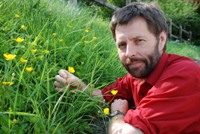Geriatric buttercups

Dr John Warren
12 May 2008
The Science of Geriatric Buttercups
There is a well known crude method for estimating the age of a hedge, by counting the number of woody species in 30m and assuming 100 years per species. But how can you estimate the age of a meadow? Well scientists at Aberystwyth University think they might have solved this problem but they want your help to test out the theory across the UK.
The work is being lead by Dr John Warren of the University's Institute of Biological, Environmental and Rural Sciences (IBERS).
“The idea is simple, and is based on the fact that many plants reproduce vegetatively and by doing so live to great ages,” he said. “However, as we all know as things grow old; they tend not to work quite as well as when they were younger. Preliminary research has shown that old buttercups from older pastures are more likely to have extra petals than young buttercup in newly established fields. Therefore looking at the proportion of buttercups in a field with more than five petals may indicate the age of the field (ie tell us when it was last ploughed).”
So how can you help?
You need to be able to do a couple of easy things and a couple of tricky things:
1. Find a field containing lots of flowering buttercups (easy).
2. Find an estimate of the age of the field (when was it last ploughed) by asking the landowner, or local historian (tricky).
3. Make sure you can identify the creeping buttercup (tricky) details below.
4. Look at 100 creeping butter cup flowers and simply count the number with more than 5 petals (easy).
5. E-mail the estimated field age, number of flowers with additional petal, the location and date to Dr John Warren at jhw@aber.ac.uk.
How to identify creeping buttercup or Ranunculus repens to give its scientific name?
There are three common species of buttercups in British pastures. The creeping buttercup is the most common.
Creeping buttercups can easily be distinguished from meadow buttercups because creeping buttercup leaves are in three parts with a short stalk connecting the middle section
Creeping buttercups can be readily distinguished from the third species, the bulbous buttercup, because just behind the flowers of the bulbous butter cup are ‘sepals' which fold back over the flower stalk.



